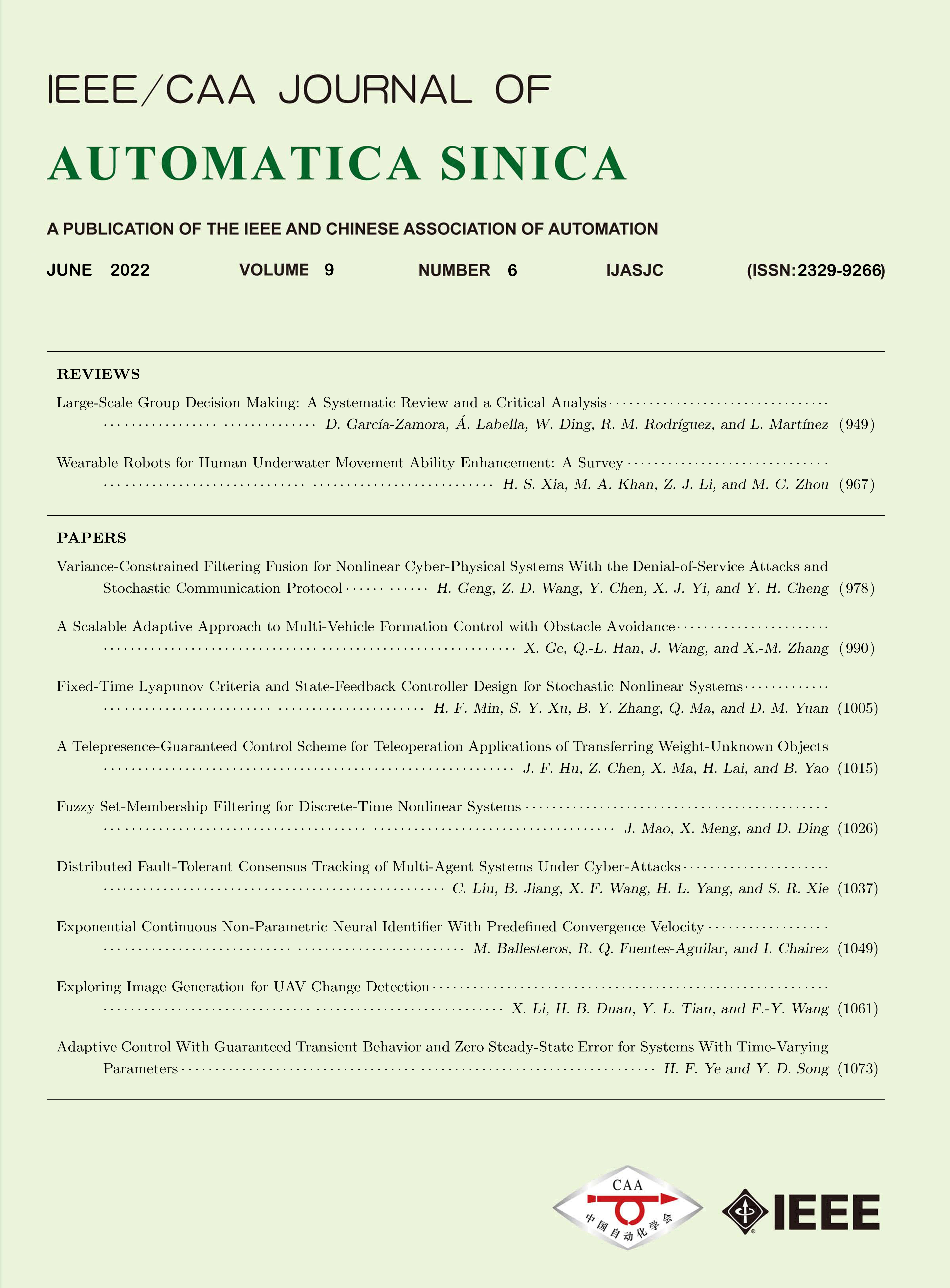 Volume 9
Issue 6
Volume 9
Issue 6
IEEE/CAA Journal of Automatica Sinica
| Citation: | S. Li, Y. Liu, and X. B. Qu, “Model controlled prediction: A reciprocal alternative of model predictive control,” IEEE/CAA J. Autom. Sinica, vol. 9, no. 6, pp. 1107–1110, Jun. 2022. doi: 10.1109/JAS.2022.105611 |

| [1] |
Y. Liu, Z. Liu, and R. Jia, “DeepPF: A deep learning based architecture for metro passenger flow prediction,” Transportation Research Part C: Emerging Technologies, vol. 101, pp. 18–34, 2019. doi: 10.1016/j.trc.2019.01.027
|
| [2] |
Y. Liu, C. Lyu, Y. Zhang, Z. Liu, W. Yu, and X. Qu, “DeepTSP: Deep traffic state prediction model based on large-scale empirical data,” Communications in Transportation Research, vol. 1, p. 100012, 2021.
|
| [3] |
L. Zhao, Y. Song, C. Zhang, Y. Liu, P. Wang, T. Lin, M. Deng, and H. Li, “T-GCN: A temporal graph convolutional network for traffic prediction,” IEEE Trans. Intelligent Transportation Systems, vol. 21, no. 9, pp. 3848–3858, 2020. doi: 10.1109/TITS.2019.2935152
|
| [4] |
C. Li, Y. Xie, G. Wang, X. Zeng, and H. Jing, “Lateral stability regulation of intelligent electric vehicle based on model predictive control,” J. Intelligent and Connected Vehicles, vol. 4, no. 3, pp. 104–114, 2021.
|
| [5] |
F.-Y. Wang, N.-N. Zheng, D. Cao, C. M. Martinez, L. Li, and T. Liu, “Parallel driving in CPSS: A unified approach for transport automation and vehicle intelligence,” IEEE/CAA J. Autom. Sinica, vol. 4, no. 4, pp. 577–587, 2017. doi: 10.1109/JAS.2017.7510598
|
| [6] |
A. Caprara, M. Fischetti, and Toth, “Modeling and solving the train timetabling problem,” Operations Research, vol. 50, no. 5, pp. 851–861, 2002. doi: 10.1287/opre.50.5.851.362
|
| [7] |
J. Högdahl, M. Bohlin, and O. Fröidh, “A combined simulation-optimization approach for minimizing travel time and delays in railway timetables,” Transportation Research Part B: Methodological, vol. 126, pp. 192–212, 2019. doi: 10.1016/j.trb.2019.04.003
|
| [8] |
Z. Hou, H. Dong, S. Gao, G. Nicholson, L. Chen, and C. Roberts, “Energy-saving metro train timetable rescheduling model considering ATO profiles and dynamic passenger flow,” IEEE Trans. Intelligent Transportation Systems, vol. 20, no. 7, pp. 2774–2785, 2019. doi: 10.1109/TITS.2019.2906483
|
| [9] |
M. Abdolmaleki, N. Masoud, and Y. Yin, “Transit timetable synchronization for transfer time minimization,” Transportation Research Part B: Methodological, vol. 131, pp. 143–159, 2020. doi: 10.1016/j.trb.2019.12.002
|
| [10] |
J. Wang, Y. Sun, Z. Zhang, and S. Gao, “Solving multitrip pickup and delivery problem with time windows and manpower planning using multiobjective algorithms,” IEEE/CAA J. Autom. Sinica, vol. 7, no. 4, pp. 1134–1153, 2020. doi: 10.1109/JAS.2020.1003204
|
| [11] |
L. Li, Y. Lv, and F.-Y. Wang, “Traffic signal timing via deep reinforcement learning,” IEEE/CAA J. Autom. Sinica, vol. 3, no. 3, pp. 247–254, 2016. doi: 10.1109/JAS.2016.7508798
|
| [12] |
Y. Liu, F. Wu, C. Lyu, S. Li, J. Ye, and X. Qu, “Deep dispatching: A deep reinforcement learning approach for vehicle dispatching on online ride-hailing platform,” Transportation Research Part E: Logistics and Transportation Review, vol. 161, p. 102694, 2022.
|
| [13] |
X. Li, Y. Liu, K. Wang, and F.-Y. Wang, “A recurrent attention and interaction model for pedestrian trajectory prediction,” IEEE/CAA J. Autom. Sinica, vol. 7, no. 5, pp. 1361–1370, 2020.
|
| [14] |
Y. Liu, C. Lyu, X. Liu, and Z. Liu, “Automatic feature engineering for bus passenger flow prediction based on modular convolutional neural network,” IEEE Trans. Intelligent Transportation Syst., vol. 22, no. 4, pp. 2349–2358, 2021. doi: 10.1109/TITS.2020.3004254
|
| [15] |
M. Palatucci, D. Pomerleau, G. Hinton, and T. Mitchell, “Zero-shot learning with semantic output codes,” in Proc. 22nd Int. Conf. Neural Information Processing Systems, pp. 1410–1418, 2009.
|
| [16] |
E. F. Ohata, G. M. Bezerra, J. V. S. das Chagas, A. V. L. Neto, A. B. Albuquerque, V. H. C. de Albuquerque, and P. P. Reboucas Filho, “Automatic detection of COVID-19 infection using chest X-ray images through transfer learning,” IEEE/CAA J. Autom. Sinica, vol. 8, no. 1, pp. 239–248, 2021. doi: 10.1109/JAS.2020.1003393
|
| [17] |
Z. Liu, Y. Liu, Q. Meng, and Q. Cheng, “A tailored machine learning approach for urban transport network flow estimation,” Transportation Research Part C: Emerging Technologies, vol. 108, pp. 130–150, 2019. doi: 10.1016/j.trc.2019.09.006
|
| [18] |
M. Schuster and K. K. Paliwal, “Bidirectional recurrent neural networks,” IEEE Trans. Signal Processing, vol. 45, no. 11, pp. 2673–2681, 1997. doi: 10.1109/78.650093
|